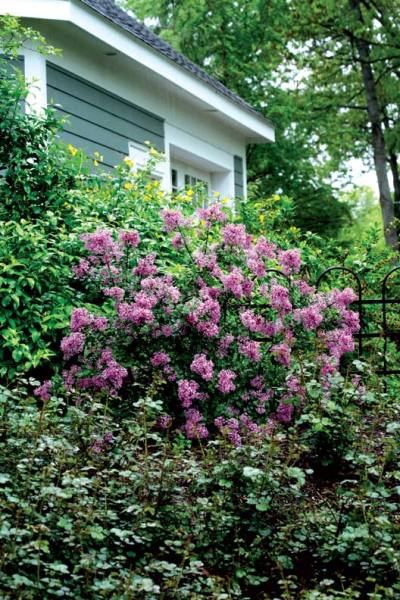
Lilacs are an old-house staple; new varieties like Bloomerang Purple have a longer growing season. (Photo: Courtesy of Proven Winners)
Lilacs’ romantic looks and honeyed fragrance evoke Victorian gardens and sumptuous bouquets. In full spring glory, the soft, panicled blooms of lavender, purple, white, or pink bedeck the bushy shrubs, inspiring ooohs and ahhs. If only the show lasted longer: After just two weeks, the flowers fade, transforming most lilacs into plain shrubs with little landscape appeal. For this reason, they’ve become unpopular with design-savvy gardeners and are grown only by diehard fans (or those who inherit them with their old houses). But this doesn’t have to be the case. A few lilacs break the mold by offering long-lasting good looks without shirking on flower quality.
Lilac Lore
The long history of lilacs is comparable only to that of roses, lilies, and tulips. The most familiar common lilac (Syringa vulgaris) is a large, multi-stemmed shrub from the mountains of southeastern Europe. Its voluptuous, fragrant blossoms were first brought to the courts of Vienna in the 1500s, and their popularity rapidly spread throughout northern Europe. In the 1600s, they were imported to the New World by colonists seeking a piece of home. By the Revolutionary War, lilacs were common across eastern North America and eventually moved westward with pioneers.
The flowers were ubiquitous in 19th-century paintings, songs, and poems. Claude Monet’s Resting Under the Lilacs (1873) depicts a time when they were an Old World garden standard—a popularity echoed in New World works. “The Lilac” (1888), a classic American song by Gustave H. Kline, tells of love shared through lilac blossoms, and Walt Whitman’s stirring poem “When Lilacs Last in the Dooryard Bloom’d” (1900) speaks of lilacs as an eternal symbol of spring. Americans commonly planted lilacs near their entry doors, where the delicate spring flowers could be most appreciated.
It’s hard to say when lilacs fell out of favor, but most point to a gradual shift in gardeners’ needs. Landscape design and “curb appeal” took precedence over the fleeting beauty of seasonal flowers, and lilac breeders didn’t help the cause by continuing to focus on bigger, better blooms rather than long-term good looks and higher pest and disease resistance. In his latest Encyclopedia of Trees and Shrubs, author Michael Dirr writes of common lilacs, “It is unfortunate that such a treasured shrub with such wonderfully fragrant flowers should [still] have so many flaws.”
That said, there are some lilacs that break the mold. Several new varieties and revered species alter the status quo by providing continuous beauty to the garden.
Lilac Maintenance
Lilacs need a few basics for good health. A site with full sun and ample airflow will encourage the best habit and flowering while discouraging foliar diseases like powdery mildew. It’s also essential to plant lilacs in average to fertile soil that’s slightly alkaline to neutral and has good drainage. Bone meal is a good, all-natural fertilizer for lilacs and should be spread around the canopy shadow at the rate of ¼ cup for every ¼” of trunk diameter. These remarkably hardy shrubs grow best in cold climates, often tolerating USDA hardiness zones 3 and 4, but may become stressed in areas with hot summer days and nights (daytime temperatures over 85 degrees Fahrenheit and nighttime temperatures over 75), so Southern growers should choose heat-resistant lilacs like ‘Cheyenne.’
Pruning should be done sparingly, if at all. Most lilacs bloom on old wood, so prune just after flowering. Dead or lilac-borer-infested stems can be removed at any time. Borer damage is easily identified by round or half-moon-shaped exit holes that appear at stem bases. Old, ungainly lilacs can be rejuvenated by cutting back the oldest stems by one third while retaining the strongest new shoots.







